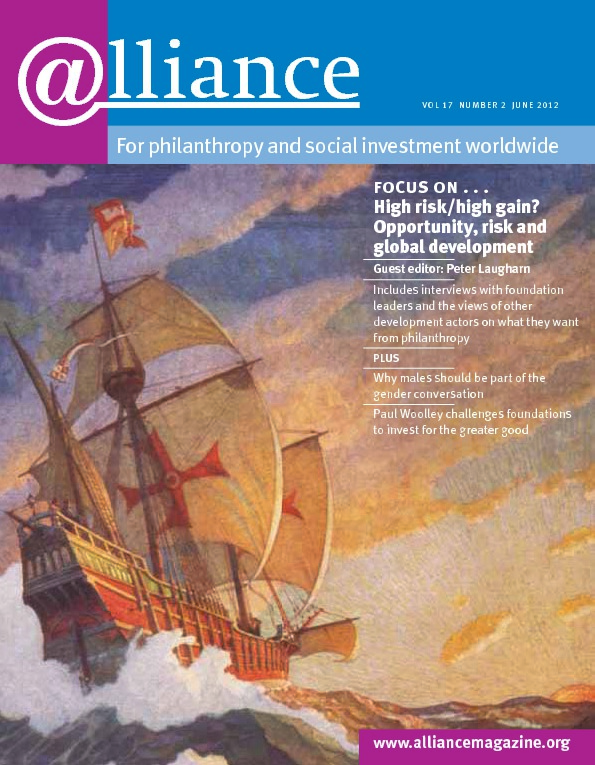How can investment advisers help foundations make sustainable and impact investments? There are great expectations that endowed foundations will act as the catalytic investors to ‘prime the pump’. In the hope that we could raise the profile of current practitioners and help to unlock far greater capital flows into the sector, Bridges Ventures asked me, as the first participant on their Bridges Fellowship Programme, to research the role of investment advisers in building the sustainable and impact investment market. Although my research included the broad spectrum of asset owners, this article focuses primarily on foundations.
As investors, foundations appear uniquely positioned to be ‘first movers’: they have access to high risk capital (grantmaking budgets) and large investment portfolios with long time horizons, and their fundamental purpose is to achieve a social or environmental mission.
Much influential leadership in building the sector has come from the US foundation community.[1] Likewise, some UK and European foundations are blazing trails, captured in an excellent report by the Mistra Foundation (2011) and seen in the capacity-building efforts of a cadre of UK foundations.[2]
Nevertheless, interviews suggest slow progress towards redeploying the ‘corpus’ – the combined endowment capital and annual income – of charitable foundations into mission-related (MRI) and programme-related (PRI) portfolios. There is either insufficient confidence among trustees that these approaches will achieve the foundation’s goals as effectively as traditional investing or grantmaking, or insufficient infrastructure to help them make a meaningful shift. The structure of boards of trustees, usually voluntarily giving their time, can foster conservativism. Further, those to whom they normally turn for advice often do not themselves know the sustainable and impact investment market.
It is notable, for instance, that the pioneering foundations in the UK have thus far largely developed their activities without the involvement of their conventional investment managers or other advisers. Their interest in social investment has been driven by internal champions.
But these are exceptional cases. Demand for sustainable and impact investments will grow only when ‘status quo’ foundations start to take an interest. We believe there is an important role to be played by specialist advisers, who know the regulatory environment and the investment ‘pipeline’ and can come prepared with vetted ‘model’ portfolios, funds or direct opportunities.
Our research also suggests that PRI, funded by the grantmaking budget and so raising fewer fiduciary concerns, may be adopted more readily than MRI, which involves investment capital. In-house grantmakers may not have the needed skill sets, however, and thus external impact-first specialist advisers can help – though how advice will be compensated is a question.
Nevertheless, capital flows at scale will start only by starting to unlock endowment capital – and there are some big hurdles. Trustees normally rely largely on their conventional asset manager to guide them on all investment choices. If they do not make a persuasive case for MRI, it is not likely to happen. This is why it is vital for mainstream advisers to be in a position to advise on sustainable and impact investment, or to have access to specialist expertise.
Although there are already ground-breaking advisers serving this market (several of whom are interviewed for our report), and many mainstream advisers interviewed said they do discuss ethical preferences or social investment with their charitable clients, their ability to implement anything but quite traditional socially responsible investment fund strategies is generally limited, despite an increasing supply of credible product offerings. Few mainstream advisers can engage in a sophisticated conversation about how to align a foundation’s investment policy with its charitable mission, and how to accomplish this without financial trade-offs.
In the wake of the publication of the Charity Commission’s CC14 guidance, it is an opportune time for specialist advisers to put PRI and MRI squarely on the agenda, either directly with foundation clients or as a service to help mainstream institutions evolve and meet the spectrum of clients’ emerging needs. They can play a transformative role, relieving foundations of the burdens of sourcing and due diligence and aggregating demand to make the market accessible and worthwhile for bigger fund managers.
1 Notably the Rockefeller Foundation and the Global Impact Investment Network, and US foundations focused on investing in this way, such as K L Felicitas, Omidyar Network, Kellogg Foundation and the F B Heron Foundation, among others.
2 Including the Esmée Fairbairn Foundation, Shell Foundation, Friends Provident Foundation, Young Foundation, Lankelly Chase, Trust for London, and Panahpur Trust.
Susannah Nicklin is a Fellow at Bridges Ventures. Email susannah.nicklin@gmail.com
For more information
To download the full report when published, visit http://www.bridgesventures.com
 An adviser’s view – Annachiara Marcandalli
An adviser’s view – Annachiara Marcandalli
Is the interest in social investment among foundations growing?
Yes, I think it’s something that a number of foundations are asking themselves about. They realize that their grantmaking can only go so far in achieving their missions, so they are constantly faced with the question of how to do things differently. Many of them are seeing more interest among their normal investment managers in the environment and social processes and governance impacts and this is having an influence on them. So there’s an increasing need to tackle the general use of their capital and then to explore whether the returns from it are enough to support their chosen initiatives and whether there are other ways that they could be supporting them.
Does the new CC14 guidance change things?
It does because it clarifies the situation. Also, while people were waiting for the Charity Commission to issue guidance there was a wonderful excuse not to do anything. The guidance has made it clear that it’s really the responsibility of trustees and staff according to how they understand the mission of the organization.
Do you plan to discuss social investment with your foundation clients as a matter of course?
We’ve always asked them about it. We help institutions reach their objectives. If it clearly doesn’t fit with their objectives, we wouldn’t push them. I think what is most important is that an organization is true to itself and goes through a process of understanding what it is and how it needs to invest its money. But the fact that we have a group of consultants who have worked with foundations that have gone down the social investment route is reassuring to others. We now have a dedicated group that has done focused research in the space and can assist clients in identifying managers, comparing the opportunities that they offer. We can also offer clients case studies and frameworks, so they don’t feel like they are walking into the unknown. That is important and it can sway decision-making.
Annachiara Marcandalli is a managing director at investment manager Cambridge Associates. Email amarcandalli@cambridgeassociates.com.
 An adviser’s view – John Kingston
An adviser’s view – John Kingston
Is the interest in social investment among foundations growing?
As part of my investor advisory services work with Social Finance, we have met with over 25 trusts and foundations over the past few months. Interest in social investment is undoubtedly growing. The majority of foundations interviewed are motivated to use social investment as a new tool in their toolbox in order to increase their programmatic impact. Many are starting off by experimenting with a few deals before developing a clear investment strategy. Around 25 per cent are engaging in social investment to support the development of the market and to increase the supply of capital to the sector. So it is still early days but the tide is now coming in.
Charities need access to capital for three key reasons: long-term loans for property purchase and refurbishment; working capital to manage cash flow; and growth capital to invest in building organizational capacity to achieve more impact. Over the past ten years, the availability of long-term secured loans from banks has developed substantially, but the supply of risk capital, both to underpin cash flow and to invest in growth, remains inadequate.
How does the new CC14 guidance change things?
The newly revised Charity Commission investment guidance confirms that charities can use programme related and mixed motive investments to deliver their charitable mission. It should hopefully pave the way for more trusts and foundations to engage in social investment. A review of the Charities Act, led by Lord Hodgson, is also under way. This could lead to a strengthening of the legal underpinning of the revised Charity Commission guidance to give charities confidence when engaging in social investment.
Do you now plan to discuss social investment with your foundation clients as a matter of course?
Yes, foundations are increasingly asking for guidance. Advice is often needed right across the investment process. And the majority of foundations, including those that are already actively engaged, do not have dedicated internal resources for social investment. So an investor advisory services business is ideally placed to help.
How do you see social investment by foundations, using their corpus, developing?
Charitable foundations are increasingly thinking about how to maximize the effectiveness of all their resources including investment assets, people, intellectual property and networks. The recently published report by Richard Jenkins on the governance and financial management of endowed charitable foundations highlights the ways different organizations are doing this.
John Kingston is an adviser to Social Finance, chair of the Association of Charitable Foundations and a non-executive director of Big Society Capital. Email john.kingston@socialfinance.org.uk



Comments (0)